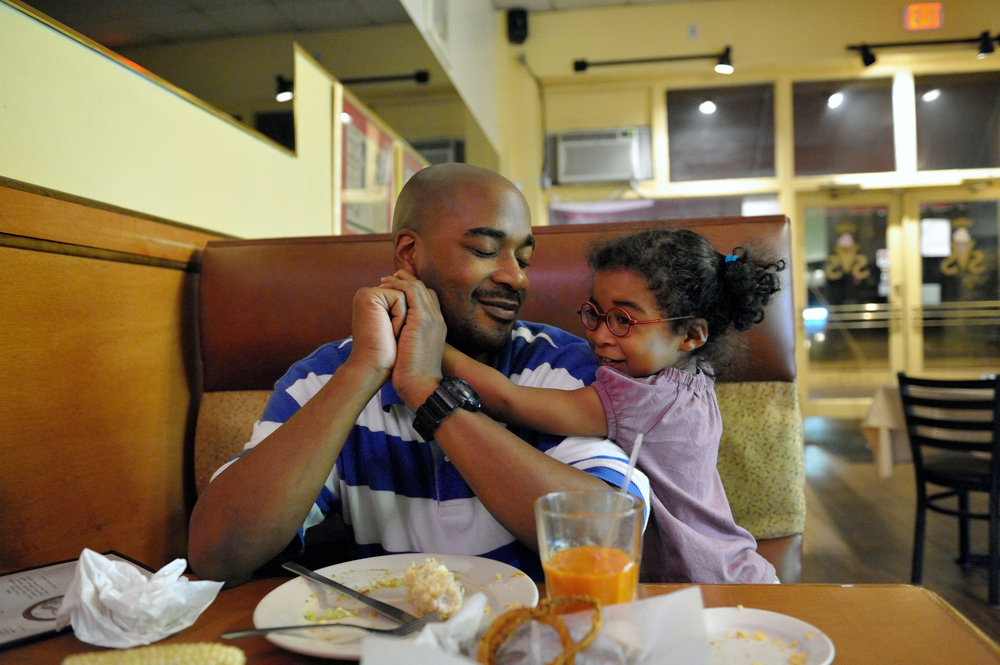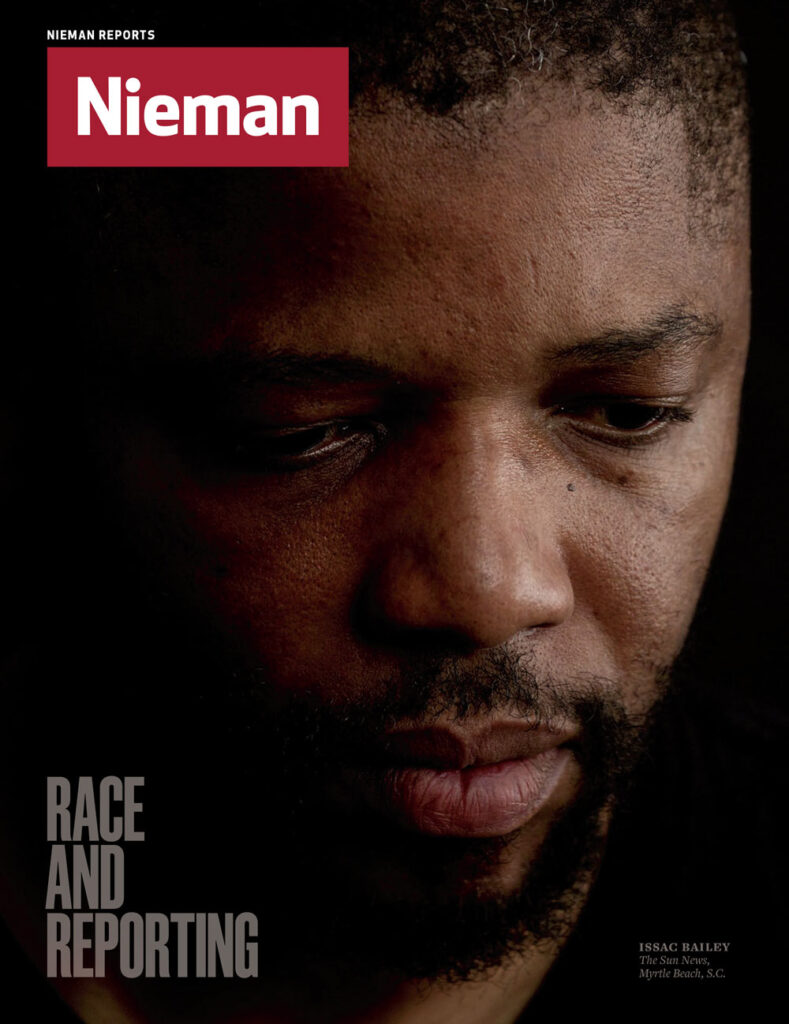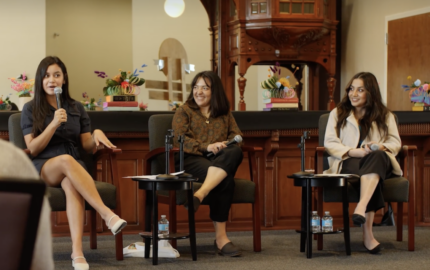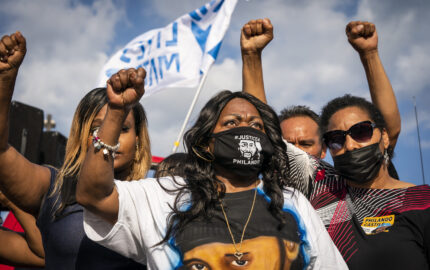The news industry has been talking about diversity for decades, but the talk, many say, often has not been followed by action. “The needles never really seem to move,” says Nikole Hannah-Jones, a reporter covering racial injustice for The New York Times Magazine. In 1968, when President Lyndon B. Johnson’s National Advisory Commission on Civil Disorders published what’s known as the Kerner Report, it concluded that America was “moving toward two societies, one black, one white—separate and unequal.”
The commission, tasked with determining the causes of and finding solutions for the riots that had been scarring the country for much of the decade, singled out the media for their inadequate coverage of African-Americans. “It would be a contribution of inestimable importance to race relations in the United States simply to treat ordinary news about Negroes as news of other groups is now treated,” the report stated.
The Kerner Report also criticized newsrooms for the disproportionately low percentage of minorities employed in the industry. Today, with attention turned to race relations in cities like Ferguson, Baltimore, and Cleveland, the needle on inclusion in mainstream newsrooms seems stubbornly stuck in place. The number of journalists of color has slowly climbed since the Kerner Report’s release, peaking around 2008, but that hasn’t necessarily translated into more equitable coverage. In a 2014 study by the American Press Institute and the Associated Press-NORC Center for Public Affairs Research, only 25 percent of African-Americans and 33 percent of Hispanics said the news media accurately portrayed their communities.
That could have something to do with who’s making the coverage decisions. The 2014 Newsroom Census conducted by the American Society of News Editors (ASNE) found that only 15 percent of daily newspapers surveyed in 2013 had a person of color in one of their top three newsroom leadership positions. “Unfortunately, the ASNE census shows the industry isn’t making much progress,” says Karen Magnuson, who chairs ASNE’s diversity committee. “In fact, we’re losing significant ground as minority populations continue to grow.”
“I have been hearing ever since I got into this business, ‘We’ve got to adapt. Our country is changing. If we don’t start telling those stories and reaching those communities, we’re going to oversee our own demise,’” says Hannah-Jones, hired by The New York Times Magazine this spring after covering racial injustice for ProPublica. “I’m going to call bullshit on that, because we’ve been hearing the same thing for decades. Newsrooms have not really changed. Until the mastheads at the top of organizations understand how critical this reporting is for our democracy, it’s not going to change. Why do we not cover [race] with the same intensity and skepticism and, really, doggedness that we cover everything else?”
The New York Times came under fire early this year when its sole reporter on the national race and ethnicity beat, Tanzina Vega, was reassigned to cover courts in the Bronx. At the time, executive editor Dean Baquet told public editor Margaret Sullivan, “I haven’t decided what to do about the beat, but I know that it has to be covered paper-wide.” The Times declined to make an editor available to comment for this story, but executive director of corporate communications Danielle Rhoades Ha said in an e-mail, “We continue to cover issues related to race and ethnicity aggressively” and cited examples of recent stories, including a series that uncovered rampant racism and abuse of staff in nail salons. Vega has since left the Times for CNN Politics.
Census projections indicate that minorities will become a majority in the U.S. by 2044. While some progress has been made in covering communities of color—NPR’s Code Switch project on race, ethnicity, and culture; the Associated Press’s race and ethnicity beat; the Chicago Tribune’s “Exploring Race,” an online forum that ran from 2008 to 2010; The Root, recently acquired by Univision; the now-defunct NBCLatino, and Fox News Latino are just a few examples—much still needs to be done. And journalists often find it difficult to have open, honest conversations about race and ethnicity—even compared to other contentious newsroom issues, like gender imbalances—for fear of damaging relationships with editors or colleagues.
“I think that the problem is that racial issues still make more people uncomfortable than women’s issues,” says Anna Holmes, founder of feminist blog Jezebel and an editor at Fusion. “Also, the fact that there are fewer people of color in the media, for a variety of reasons, than women might have something to do with that, which is why I think pushing for newsroom diversity is important. … I do see a lot more discussion of race, but I don’t think it’s at the point where it’s accepted that looking at race in America is part of the standard operating procedure of most media outlets.”
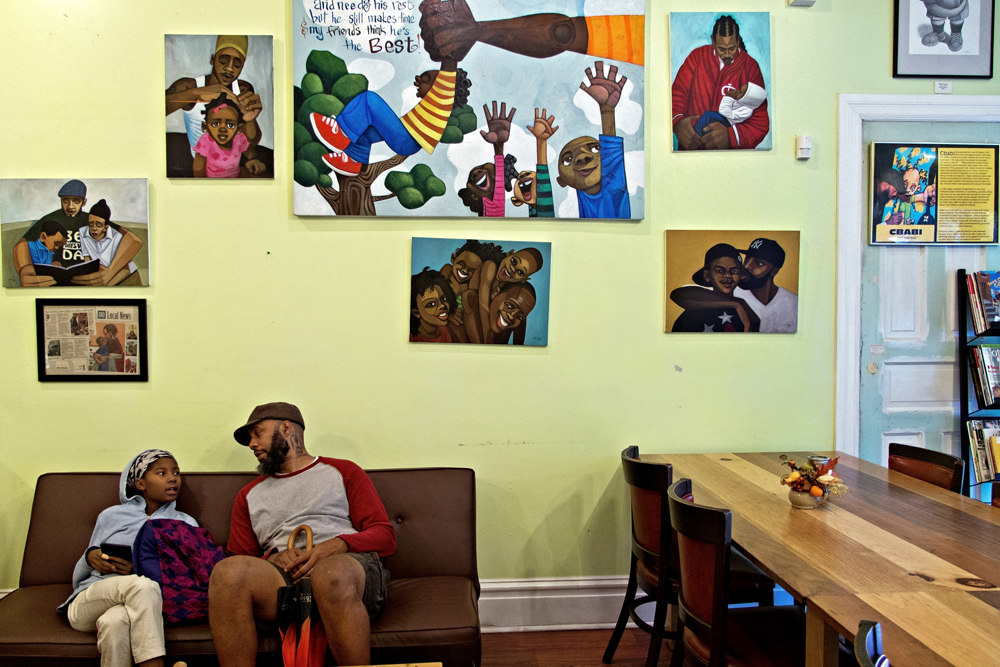
Some outlets are trying to change that. Last October, BuzzFeed editor in chief Ben Smith published some of the diversity numbers for his newsroom. Of its 185 editorial employees, 72.7 percent were white, with 9.8 percent Hispanic, 7.1 percent Asian, and 6 percent black. He called on newsroom managers to work harder to improve diversity by writing job descriptions that don’t presume the gender or race of candidates and by sending postings to journalists “connected to underrepresented communities.” “We are modestly more diverse than we were last September and are moving in the right direction,” Smith says now, “because people doing the hiring see it as a priority.” He cites BuzzFeed Life—which focuses on food, health, beauty, and style—as a team that has been especially focused on reflecting the diversity of its audience in its staff. New hires include Nora Whelan, who covers plus-size style and beauty, and Essence Gant, whose writing has focused on black beauty.
Apart from the ethical imperative, one of the reasons Smith gave for why diversity matters is “reaching more readers.” “The Internet is, in some ways, organized around identity,” he wrote in that October 2014 BuzzFeed post. “We are a new kind of media company with the opportunity to reach a huge global audience, and we need to build an organization that’s capable of connecting with a vast range of readers.” Case in point: When BuzzFeed noticed that Latinos were underrepresented among its readership, editors launched new content initiatives—including everything from in-depth immigration coverage to quizzes and listicles that speak to a Latino audience—across the News, Buzz, and Life divisions that significantly increased its Latino audience from January 2014 to January of this year.
Another of Smith’s arguments for diversity is that it “helps editorial organizations avoid the bland and often false conventional wisdom held in a room full of people who come from similar places.” That’s a guiding principle as well at The Atlanta Journal-Constitution, where editor Kevin Riley admits, “As a white man, I can avoid race if I want. I live with that white male privilege. Unless you are exposed to the idea that people of color do not have that option, and race is in front of them all of the time, you don’t have that awareness, and therefore it makes it much harder to compel yourself to act, to hear the kind of things you need to hear to take action in the newsroom.”
A diverse newsroom staff can lead to a richer variety of stories about people of color
And the Journal-Constitution has taken action. Among the paper’s top staff—three managing editors, three deputy managing editors, and an editorial page editor—there are two white males, two African-American females, one white female, and two African-American males. The paper is helped, according to Riley, by the fact that it’s part of a corporation, Cox Media Group, which he says takes diversity seriously. Cox recently began a year-long fellowship for recent college graduates of color who want to pursue a digital project at one of the company’s properties, which include TV and radio stations as a well as newspapers. To date, all eight fellowship recipients have gone on to full-time jobs with the company. Cox also runs mandatory diversity awareness workshops aimed at creating an environment in which staff feel comfortable talking about race and ethnicity.
“When you have a diverse staff, and people are comfortable around these topics, you get a better outcome,” Riley says. “That’s sort of the business payoff. This is beyond just a nice idea, beyond the right thing to do, and beyond recognizing our troubled history around race. It’s a business imperative.” For Riley, that imperative pays off in better stories that better serve readers.
“Black & Blue,” a collection of 14 first-person stories by African-Americans about interactions with police, is the kind of coverage Riley has in mind. The series included a business owner whose car was searched by police after he called to report a shooting and Journal-Constitution editor Todd C. Duncan’s story about being pulled over by police when he was 17, slammed to the hood of his car, then left alone without an explanation or apology. Riley also mentions a column by Gracie Bonds Staples about pointed remarks regarding race that Michelle Obama made in her Tuskegee University commencement speech and at the dedication of an art museum in New York. “I’m not prepared to say a white reporter couldn’t do that [story],” Riley says, “but I just think that when you can comfortably get into a topic like that with some perspective and voice, you’re better off.”
For Riley, “There’s no way around a personal commitment to diversity. You can mandate it at a certain level. You can require it in hiring. Those things help. … But in the end, we all have to look at ourselves in the mirror and say, ‘Do I care about this? And if I care, What am I doing about it?’ ”
While many news outlets face layoffs or hiring freezes, The Washington Post, bought by Amazon founder and CEO Jeff Bezos in 2013, hired 114 journalists last year; 40 of them, or about 35 percent, were journalists of color. “You have to think about the makeup and the mix,” says Kevin Merida, a Post managing editor. “Do you have enough people who come from different religions? People who grew up poor? People who grew up rich? People who are of every ethnicity and every race and are young and veterans? That’s really why you want to have a diverse newsroom: Because we’re in the business of explaining people to each other. How can we do that if we don’t have enough variety in our newsroom?”
Merida points to “The N-Word,” a project that explored the history of the term and its place in American culture, as journalism that might not have been tackled in a less diverse newsroom. A brainstorming session in the newsroom brought together journalists of different races, genders, and ages and broke down barriers between departments. The sports editor led a discussion that involved videographers, designers, and reporters. The result: a series of videotaped conversations in which people offer powerful perspectives on the word.
Vox, too, has learned a lot about hiring, after getting slammed in 2014 because so many of its first employees were white and so few were women. The company put forward Ezra Klein as the leader, though he was one of three co-founders, including Melissa Bell, his colleague from The Washington Post, and Matthew Yglesias, from Slate. Bell says the intense scrutiny taught them to widen outreach, create a welcoming culture, and create clear career paths at Vox. “We learned a couple things,” Bell says. “One of the biggest things was making sure you’re doing a lot of outreach and that you’re trying to find different networks. You have to actively seek out people.”
Vox does that in part via an internal Google document that tracks writers of interest. When staff come across journalists whose work could add value to what Vox is doing or who cover topic areas Vox might want to get into, their names go on the list. “When we have positions open, those are people that we start contacting in the beginning,” says Bell. She and her colleagues also look for job candidates through organizations focused on bringing more women and minorities into technology. Blacks in Technology, the Levo League, an online career-development network geared toward young women, and Tech LadyMafia all focus on that goal.
What Bell is trying to do for Vox, Emma Carew Grovum is trying to do for the industry as a whole. Back in late 2010, Retha Hill, director of the Digital Innovation and Entrepreneurship Lab at Arizona State University’s journalism school, wrote a blog post for PBS MediaShift about how to increase the number of people of color speaking at prominent new media conferences. The piece generated a lot of conversation on Twitter, and Carew Grovum, a member of the Asian American Journalists Association, says she “was very, very surprised to see people saying, over and over again, ‘We can’t find qualified minorities.’ I realized I kept waiting for somebody to say, ‘This is absurd. I can name a dozen people off the top of my head who would be great for these kinds of conversations.’”
Tired of waiting, Carew Grovum, who recently joined the staff of The New York Times Opinion section after working at Foreign Policy magazine, got together with mentors, friends, and colleagues to launch the Journalism Diversity Project (JDP), a curated list of journalists of color. Starting out as a simple Google Spreadsheet, the JDP quickly became a combination database and website listing people, as Carew Grovum puts it, “you would want to see speak at a panel, would hire into your newsroom because they’re doing amazing work, and happen to be of color.” Conference planners, such as the Association of Alternative Newsmedia and Associated Press Media Editors, have used the list to find speakers, while SRCCON, a national conference for media-minded technologists, used the list to make its first conference last year a diverse gathering.
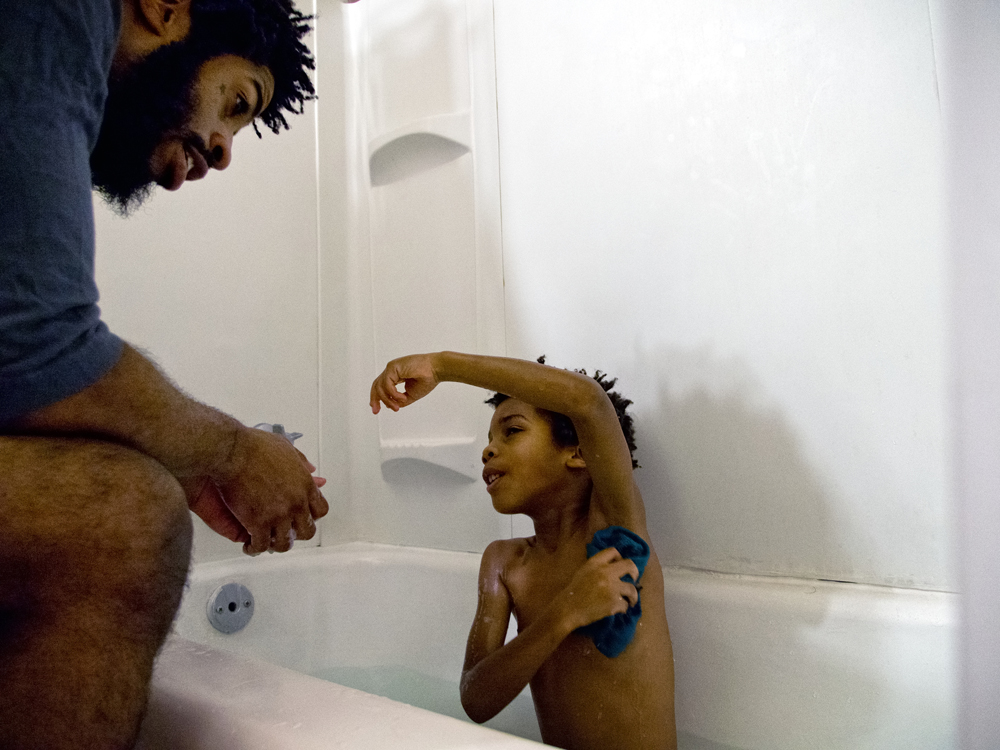
ASNE itself has programs in place to help enhance diversity, including its Minority Leadership Institute, which provides professional development for mid-level editors and business executives. Other initiatives include the Online News Association and Poynter’s Leadership Academy for Women in Digital Media, a free week-long seminar; the Asian American Journalists Association’s newly launched I-Con, an invitation-only leadership event that will be held in Miami this fall; the Robert C. Maynard Institute for Journalism Education, which trains journalists in leadership and multimedia skills; and many others.
In 2012, when 17-year-old Trayvon Martin was killed by neighborhood watch member George Zimmerman, three African-American journalists and a white lawyer championed the undercovered story about the shooting death of the black teen and helped elevate it to international prominence. Trymaine Lee, then a reporter for The Huffington Post’s Black Voices, persistently covered the story. Columnists Charles M. Blow of The New York Times and Ta-Nehisi Coates of The Atlantic brought a national audience. About 10 days after the shooting, attorney Kevin Cunningham, a Howard University alum, created a Change.org petition asking the state of Florida to prosecute Zimmerman for the murder of Martin. The coverage and the petition were amplified on social media, which led to further reporting from other outlets. Entrepreneur and rapper MC Hammer and singer Janelle Monae tweeted about the petition and, as Twitter traffic around #WeAreAllTrayvonMartin increased, so did news attention, until Trayvon Martin’s killing became a focal point for America’s ongoing conversation about race.
Newsroom diversity has also spurred impactful coverage at the Asbury Park Press in New Jersey, where executive editor Hollis R. Towns has overseen a number of initiatives to improve the paper’s coverage of minority neighborhoods. In the past, prosecutor’s offices in Monmouth and Ocean counties were inconsistent in how they released mug shots of crime suspects, resulting in more photos of black and Latino suspects being released than of white suspects. Reporters began asking agencies for mug shots on all crime stories. When the prosecutor’s offices refused, the paper began calling them out—noting that state law allows local discretion in the release of photos—until officials in both counties began releasing more photos of suspects. “Gradually and quietly they started making the photos available to us for all types of crimes,” says Towns. “Now it’s much more equitable and there’s much more balance in the public’s view of crimes.”
[note]With reporting by Eryn M. Carlson, Jan Gardner, Tara W. Merrigan, and Jonathan Seitz[/note]
Graduation rates at Asbury Park High School, which mainly serves minorities, had hovered around 50 percent for years. The paper did a series of stories and editorials chronicling issues facing the district—low test scores and high dropout rates even as the state spent about $30,000 per student per year—that helped break a deadlock on the hiring of a new superintendent last year. The paper also worked with community partners to give students books and encourage volunteerism in the schools.
Following the deaths of Eric Garner and Michael Brown, Towns initiated a series of articles and videos about race, including personal stories—written by Asbury Park Press staffers and people from the community—sharing their thoughts on race and experiences about relationships with minorities. “We were thinking one day, How can we crystallize the recent events and discuss race in a way that’s conversational?” says Towns of the series. “The response was overwhelmingly positive, and it was good dialogue. We gave [the community] a forum to talk about issues without being preachy.”
While Towns is proud of his accomplishments, he says there is still plenty of work to be done, in his newsroom and in others around the country: “Diversity isn’t a one-time thing where someone hires a person or two and checks a box and says, ‘Okay, we’ve done our part.’ It takes time and resources to bring about diversity in coverage, diversity in thinking, and diversity in approach.”
With reporting by Eryn M. Carlson, Jan Gardner, Tara W. Merrigan, and Jonathan Seitz
